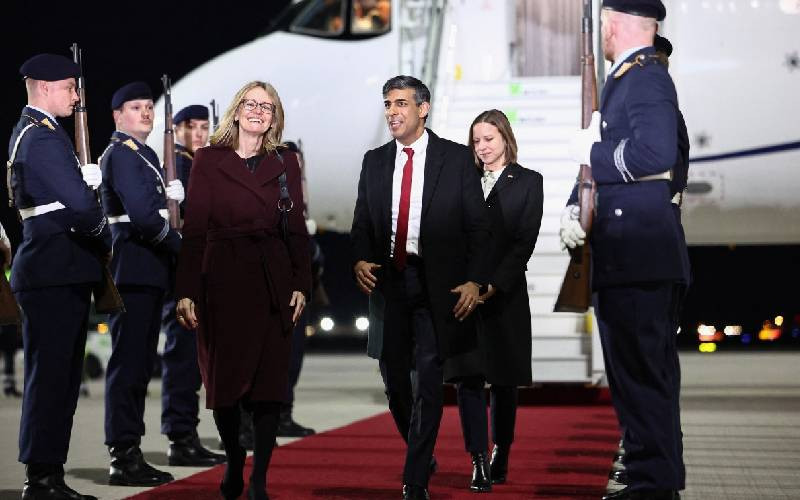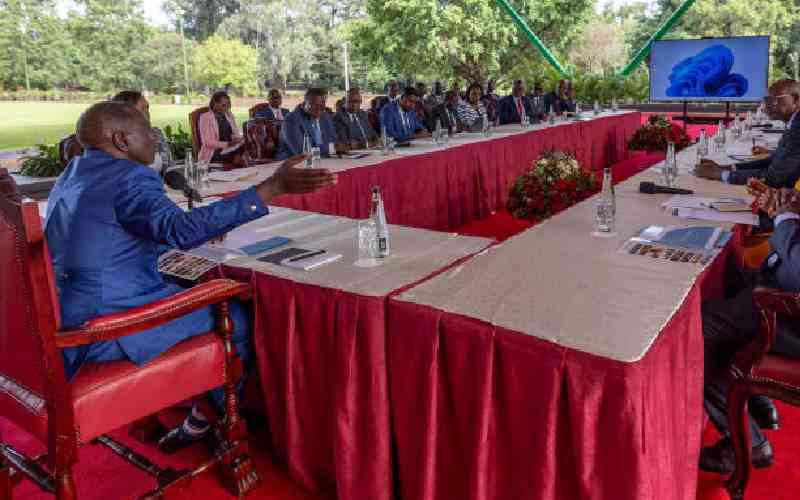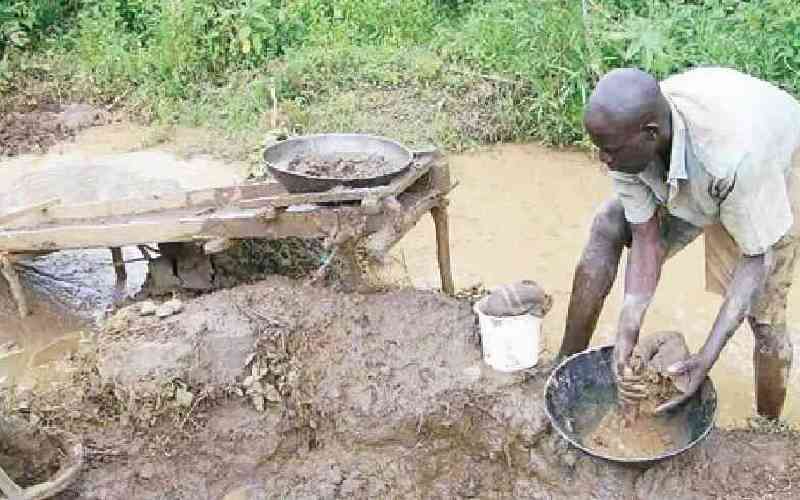The country is once again witnessing the irony of citizens dissatisfied with the delivery of public services, while money lies unused in Treasury.
Ministries have once more failed to spend the money they had requested, with the Government responding by trimming development expenditure by Sh213.6 billion (26 per cent).
A record 35 State departments have seen their development expenditure cut.
In the supplementary budget that will run up to mid next year, a cut in capital expenditure has lowered the Budget from Sh2.1 trillion to Sh1.9 trillion. However, recurrent expenditure, which largely goes towards paying salaries, has increased by Sh32.4 billion.
The latest development takes the ratio of recurrent expenditure to capital expenditure to 1.47. This means that for every Sh1 that will be spent on paying salaries, 47 cents will go towards development.
The tracking of Exchequer releases, as documented by the Office of the Controller of Budget, shows that between July 2015 and June 2016, of the Sh1.8 trillion disbursed, for every Sh1 released for development, Sh2.16 was released to pay salaries and allowances.
The trouble with cutting on development spending is that most of the country’s mega projects were supposed to earn a return to help the Government repay its huge debts.
The reduction now means Kenyans will have to foot the payments out of pocket, as projects stand unfinished.
Low absorption
The latest spending cut comes in the wake of sustained low absorption rates, and will force the Government to scale down, postpone or abandon some of the projects contained in its manifesto.
The Standard Gauge Railway, delivery of 5,000 megawatts of power, putting 1 million acres under irrigation, reviving the tourism industry and reviewing mineral wealth are among the plans that now face a new reality.
The State Department of Transport will have to do without Sh51 billion, most of which was allocated to the first phase of the Standard Gauge Railway (SGR) and roads expansion.
The consequences of this include a delay in delivering the Mombasa-Nairobi phase of SGR. The Government has changed its initial plan to finance 270 kilometres in the current financial year by sacrificing 70 kilometres.
The construction of roads and bridges will also be slowed after a third of the initial budget was slashed. Some Sh31.7 billion has been taken away from an initial Sh96.9 billion allocation.
The Government has also cut the Sports budget by Sh1 billion, even though it has not constructed a single stadium of the five promised.
Stay informed. Subscribe to our newsletter
It has emerged that the directive by Treasury Cabinet Secretary Henry Rotich that spending be based on strict work, cash and procurement plans may have caught some ministries, departments and agencies (MDAs) unawares.
The directive sparked confusion, leading to the rejection of some of the plans, and slowing Budget absorption significantly.
“It is observed that from the few submissions of these documents by MDAs, they have merely split the Budget into 12 equal installments without regard to when particular activities will be carried out and the procurement of the necessary goods and services,” Mr Rotich noted in a July 12 circular.
Data from the Treasury showed that in the first quarter of this year, only Sh41.8 billion had been spent on development against an annual budget of Sh416 billion.
With three months of the year gone, the expenditure translated to just 10 per cent. Assuming the same pace, it would mean that by the close of the financial year, just 40 per cent of the allocation would be spent, leaving Sh250 billion unused.
Budget highlights
Rotich has blamed the low absorption rate of development funds on unrealistic demands for money by ministries during Budget making.
He said many ministries are usually optimistic they will fully absorb the funds when the Budget is being made, and make demands without clear plans.
“I have realised that we end up putting a lot of money in the Budget after huge demands are made by ministries. When the fiscal year ends, we are left with a lot of funds that are not absorbed,” the CS said. He was speaking during the signing of a loan agreement between the Government and China-Exim Bank to fund road construction in Kitui and Makueni counties.
According to Treasury Principal Secretary Kamau Thugge, the supplementary budget mirrors the expected absorption rate in the remaining months of the current financial year.
“The original budget from line ministries had been based on 100 per cent absorption. But you may recall in our Budget highlights we pointed out and even presented a scenario with a more realistic absorption level,” Dr Thugge told Business Beat.
According to the 2015 report from the Controller of Budget analysing Government expenditure in the 2014-15 financial year, out of Sh696.5 billion allocated for development projects, the State only managed to spend Sh318.7 billion.
This means the funds for development were available, but MDAs spent just 45.8 per cent of the cash; the remainder was returned to the Treasury.
Over the same period, the budget for recurrent expenditure, which includes salaries and allowances, was utilised up to 89.7 per cent.
Ministries used the excuse of late disbursement to explain away their failure to spend on development.
Analysts say this year, the Government started out with a make-believe Budget; current reversals paint a more realistic picture of how the public should expect the Government to spend taxes.
Lowering the Budget will also reduce the pressure on Kenya Revenue Authority (KRA) to meet its collection targets, as well as allow for a slower rate of borrowing.
The taxman was expected to increase revenue collection to Sh1.37 trillion from a Sh1.18 trillion target set the last financial year.
“Based on historical absorption rates, the initial Budget was overambitious and the ability to execute was not considered. This is more realistic,” East African Regional Economist at CfC Stanbic Bank Jibran Qureishi, said.
Mr Qureishi added that the decision to reduce spending might also have been inspired by the need to fulfil conditions set by the International Monetary Fund (IMF) for awarding Kenya an extension on a Sh153 billion ($1.5 billion) precautionary loan for two years to support the economy against external shocks.
The IMF requires the country to narrow its Budget deficit to below 7 per cent of gross domestic product (GDP) over the term of the facility.
The country’s estimated financing gap is equivalent to 9.6 per cent of GDP this year, up from 7.2 per cent in 2015.
The Treasury has remained optimistic that it will narrow this gap, including by containing the wage bill with possible job cuts and a freeze in employment.
Increased pressure
However, the expansion in recurrent spending by Sh32.4 billion has lowered the savings made from cutting development expenditure to Sh181 billion.
And this comes on the back of the Government facing increased pressure to give civil servants pay rises. Doctors last week made good their threat to down their tools to push for higher salaries.
According to economist Robert Shaw, it is worrying for a Government’s expenditure on development to be lower than its wage bill.
“It is not encouraging that the Treasury is increasing day-to-day running costs instead of working harder to reduce day-to-day expenses,” Mr Shaw said.
He added that increasing recurrent expenditure shows the Budget cut was mainly as a result of the Government’s inability to spend money, not an exercise in prudence.
A surge in recurrent expenditure also pokes holes into the effectiveness of the 18-month job evaluation exercise carried out by the Salaries and Remuneration Commission (SRC).
The evaluation had been touted as a tool to harmonise salaries, as well as cut the wage bill, with SRC Chairperson Sarah Serem saying the report had found duplication of roles in public service.
“We need to be extremely cautious of the number of people we employ in public sector .... We noted in the job evaluation that there are jobs that have been split into several positions yet could be handled by one individual,” she said.
Growth projections
Another concern posed by the spending cuts is that growth projections will slow down given recent figures have been buoyed by Government spending on infrastructure.
However, PS Thugge dismissed this concern, saying the Treasury had already seen the possibility of lower spending and considered it in its projections.
“It is important to know that our original growth projections factored in the lower absorption levels and, therefore, there is no significant impact on our growth projections from the revised figures,” he said.
The Treasury forecasts the economy to expand by just over 6 per cent next year, down from an initial forecast of 6.5 per cent, mainly because of slowing growth in private sector credit.
Qureishi agrees with the projection, saying the weather outlook in the first half of 2017, credit growth and election anxiety will have a bigger impact on growth figures than the reduced spending on development.
Standard Chartered Plc Chief Economist for Africa Razia Khan last week cut her forecast for Kenya’s growth next year to 5 per cent from a previous estimate of 5.6 per cent. She told Bloomberg news that this is due to weaker credit growth.
Economic think tank, Focus Economics, also sees slowing private sector credit and rising political uncertainties putting pressure on the economy, which they predict to expand by 5.7 per cent next year.
The Government has already put out proposals for the 2017-18 Budget and invited submissions from the public. The Budget has been dubbed, ‘Consolidating economic gains in an environment of subdued global demand’, reflecting the Treasury’s outlook.
[email protected] and [email protected]
 The Standard Group Plc is a
multi-media organization with investments in media platforms spanning newspaper
print operations, television, radio broadcasting, digital and online services. The
Standard Group is recognized as a leading multi-media house in Kenya with a key
influence in matters of national and international interest.
The Standard Group Plc is a
multi-media organization with investments in media platforms spanning newspaper
print operations, television, radio broadcasting, digital and online services. The
Standard Group is recognized as a leading multi-media house in Kenya with a key
influence in matters of national and international interest.
 The Standard Group Plc is a
multi-media organization with investments in media platforms spanning newspaper
print operations, television, radio broadcasting, digital and online services. The
Standard Group is recognized as a leading multi-media house in Kenya with a key
influence in matters of national and international interest.
The Standard Group Plc is a
multi-media organization with investments in media platforms spanning newspaper
print operations, television, radio broadcasting, digital and online services. The
Standard Group is recognized as a leading multi-media house in Kenya with a key
influence in matters of national and international interest.









